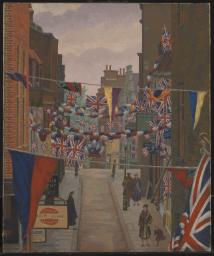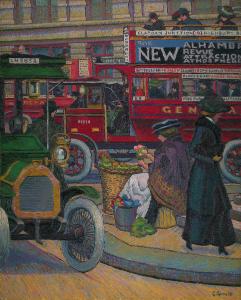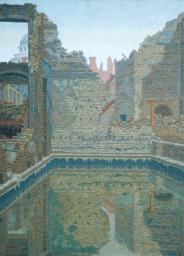Charles Ginner Hartland Point from Boscastle 1941
Charles Ginner,
Hartland Point from Boscastle
1941
This view from the window of Ginner’s sister’s house at Boscastle on the north coast of Cornwall looks towards High Cliff and Hartland Point. The colours and forms of the landscape, with tiled roofs showing through, are executed in thick layers of paint resulting in an impasto surface. The blues and whites of the sky enhance the effect of what must have been a clear day on the coast.
Charles Ginner 1878–1952
Hartland Point from Boscastle
1941
Oil paint on canvas
548 x 857 mm
Inscribed ‘C. GINNER.’ in brown paint bottom right
Presented by the Trustees of the Chantrey Bequest 1941
N05306
1941
Oil paint on canvas
548 x 857 mm
Inscribed ‘C. GINNER.’ in brown paint bottom right
Presented by the Trustees of the Chantrey Bequest 1941
N05306
Ownership history
Purchased from the artist for £55 by the Trustees of the Chantrey Bequest and presented to Tate Gallery 1941.
Exhibition history
1941
The One Hundred and Seventy-Third Exhibition of the Royal Academy of Arts, Royal Academy, London, May–August 1941 (132).
1944–5
A Selection from the Tate Gallery’s Wartime Acquisitions (Second Exhibition), (Council for the Encouragement of Music and Arts tour), Manchester City Art Gallery, November–December 1944, City Museum and Art Gallery Birmingham, January–February 1945, Walker Art Gallery, Liverpool, March 1945, Central Museum and Art Gallery, Derby, April 1945, Wakefield Art Gallery, May–June 1945, Castle Museum, Norwich, July–August 1945, Laing Art Gallery, Newcastle upon Tyne, September–October 1945, Worthing Museum and Art Gallery, October–November 1945 (26, as ‘Hartland Point’).
1945
The Tate Gallery’s Wartime Acquisitions Second Exhibition, National Gallery, London, June–July 1945 (21, as ‘Hartland Point’).
1949
The Chantrey Collection, Royal Academy, London, January–March 1949 (305).
1958
A Selection from the Chantrey Bequest, Graves Art Gallery, Sheffield, April 1958 (71).
1968
In and Around the Slade, University of Newcastle upon Tyne Artists’ Festival, Laing Art Gallery Annexe, Newcastle upon Tyne, February–March 1968 (2).
References
1952
‘Mr Charles Ginner’, Times, 7 January 1952, p.6.
1964
Mary Chamot, Dennis Farr and Martin Butlin, Tate Gallery Catalogues: The Modern British Paintings, Drawings and Sculpture, vol.1, London 1964, p.241.
2000
Wendy Baron, Perfect Moderns: A History of the Camden Town Group, Aldershot and Vermont 2000, p.175.
Technique and condition
Hartland Point from Boscastle is painted in artists’ oil paints on primed stretched canvas. There are areas of cupped distortions in the canvas resulting from the contraction of the paint, which is a common feature of Ginner’s work, associated with the thickness of the paint (see also Tate T03096). The cloth is a fine, plain-weave linen, which appears to have been sized and primed with white oil-type priming. The primer has been evenly applied and retains the fine canvas weave texture, producing a smooth, finely grained preparatory surface. No initial drawing remains visible although the composition is carefully planned and there is little evidence of changes during painting (see also Tate N05276). Ginner seems to have been remarkably consistent in his method of painting. The technique that he employed in his later years was described by his friend Marjorie Lilly:
[Ginner] applied a thin colour wash of approximately the right colours, using turpentine so that it dried quickly. Then he started his real painting with a quantity of rather small, flat brushes and in his methodical way working from left to right across the canvas, finishing the picture in one very thick coat of paint. His aim was to complete this second coat without any corrections.1
It is difficult to discern the early stages of his work owing to the thickness of the final paint layer. On the whole the technical features of this work appear familiar. The rich paint of the landscape and buildings is applied in short brushstrokes of thick paint with a controlled viscosity. The handling of the paint is used to model the forms of the landscape, and layers are methodically overlaid to build up the details, such as the tiled roofs. This accumulation of paint has produced an intricate surface of lipped impastos, which is a key characteristic of Ginner’s work. It is probable, however, that there are at least minor variations in materials and technique, in particular in his manipulation of the paint medium. The development of areas of ragged brittle cracks and cupping of the paint have resulted from layers of medium-rich colour with underlying leaner paint peeling away from the smooth surface of the priming. The paint does appear to have had other media added to the darker colours to maintain their gloss and saturation. In other areas, such as the sky, the paint is slightly leaner and drier in appearance, mirroring an effect seen in Snow in Pimlico (Tate N05270). Ginner’s careful control of the paint medium provides a technical focus for his work (see also Tate T03096) through which it is possible to discern a more experimental approach in his painting.
Roy Perry and Sarah Morgan
June 2006
Notes
How to cite
Roy Perry and Sarah Morgan, 'Technique and Condition', June 2006, in David Fraser Jenkins, ‘Hartland Point from Boscastle 1941 by Charles Ginner’, catalogue entry, May 2005, in Helena Bonett, Ysanne Holt, Jennifer Mundy (eds.), The Camden Town Group in Context, Tate Research Publication, May 2012, https://wwwEntry
This work was painted from a drawing made in the summer of 1940, which is probably the squared pencil drawing of the same title that was sold at Christie’s on 14 May 1993.1 Ginner’s sister, Ruby Ginner Dyer, wrote to the Tate Gallery on 11 and 15 August 1957 that this painting
was a view from one of the windows of my house at Boscastle, called ‘St Corentin’ ... It was studied from my house in the summer of 1940. I remember his drawing it, and he painted it from the drawings when in London and his entry of 1941 meant that he finished it at the beginning of that year for the RA.2
Boscastle is on the north coast of Cornwall near the Devon border. The view is looking due north to High Cliff and Hartland Point. The drawing must have been made on a clear day, and shows the whole west-facing coast of Devon. The small patch of sea is bright blue, matching the intense and even tones of green, grey and brown. A watercolour by Ginner, Beeney Cliff, Boscastle,3 is a closer focus of the same view, tilted downwards slightly to include a large, walled kitchen garden in the foreground, which was probably his sister’s garden. Ginner first painted here in 1915 and continued to do so until 1947. Since he painted from drawings the dates of the paintings do not necessarily indicate exactly when he stayed there, but his notebooks list Boscastle pictures in 1915, 1919, 1922, 1935 and in 1941–3.4
Ginner exhibited at the Royal Academy for the first time in 1941, showing this painting and another, Watergate, Chester. He was elected an Associate Royal Academician in 1942. In the early years of the war he painted very little; his notebooks show that in 1941 he made only three paintings and one drawing. In 1941 or 1942 he moved to Standon in Hertfordshire to stay with the painter and collector Edward Le Bas after his London studio was damaged by bombing.
The painting is listed in the artist’s third notebook under the same title, and marked as ‘Sold The Chantrey Bequest £55.0.0’.5
David Fraser Jenkins
May 2005
Notes
Related biographies
Related catalogue entries
How to cite
David Fraser Jenkins, ‘Hartland Point from Boscastle 1941 by Charles Ginner’, catalogue entry, May 2005, in Helena Bonett, Ysanne Holt, Jennifer Mundy (eds.), The Camden Town Group in Context, Tate Research Publication, May 2012, https://www







